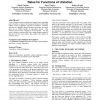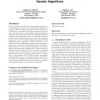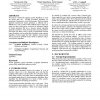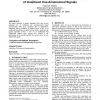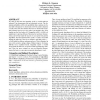GECCO
2005
Springer
15 years 1 months ago
2005
Springer
Using a dynamic systems model for the Simple Genetic Algorithm due to Vose[1], we analyze the fixed point behavior of the model without crossover applied to functions of unitation...
GECCO
2005
Springer
15 years 1 months ago
2005
Springer
In neuroevolution, a genetic algorithm is used to evolve a neural network to perform a particular task. The standard approach is to evolve a population over a number of generation...
GECCO
2005
Springer
15 years 1 months ago
2005
Springer
Genetic Algorithms (GAs) are very commonly used as function optimizers, basically due to their search capability. A number of different serial and parallel versions of GA exist. ...
GECCO
2005
Springer
15 years 1 months ago
2005
Springer
We propose a method for applying genetic algorithms to create 3D terrain data sets. Existing procedural algorithms for generation of terrain have several shortcomings. The most po...
GECCO
2005
Springer
15 years 1 months ago
2005
Springer
Genetic Algorithms (GAs) are a search and optimization technique based on the mechanism of evolution. Recently, another sort of population-based optimization method called Estimat...
GECCO
2005
Springer
15 years 1 months ago
2005
Springer
Ongoing research has established a new methodology for using genetic algorithms [2] to evolve forward and inverse transforms that significantly reduce quantization error in recons...
GECCO
2005
Springer
15 years 1 months ago
2005
Springer
This paper describes a genetic algorithm (GA) that evolves optimized sets of coefficients for one-dimensional signal reconstruction under lossy conditions due to quantization. Beg...
GECCO
2005
Springer
15 years 1 months ago
2005
Springer
We propose three distance measures for genetic search space. One is a distance measure in the population space that is useful for understanding the working mechanism of genetic al...
GECCO
2005
Springer
15 years 1 months ago
2005
Springer
We study if and when the inequality dp(H) ≤ rel∆(H) holds for schemas H in chromosomes that are structured as trees. The disruption probability dp(H) is the probability that a...
GECCO
2005
Springer
15 years 1 months ago
2005
Springer
This paper examines a real-world application of genetic algorithms – solving the United States Navy’s Sailor Assignment Problem (SAP). The SAP is a complex assignment problem ...
